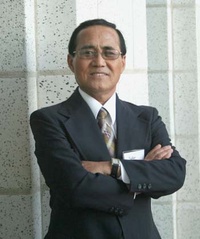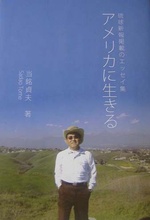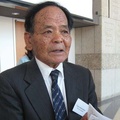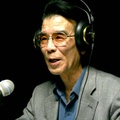Read Part 2 >>
While Higa and Kaneshiro’s Uchinanchu journalism is aimed at Uchinanchu outside of Okinawa, Sadao Tome writes stories to send a message to Uchinanchu in Okinawa. “With my writing, I want to connect America and Okinawa,” said the 68-year-old Tome, whose smiling and bespectacled eyes show unparalleled determination. Though he failed often early on, he pursued his dream of becoming a journalist for nearly three decades before finding success. It took him almost 30 years to become a successful writer.
Born in Motobucho, a town located in the middle of Okinawa, Tome went to Tokyo to attend a two-year college. He started working at Gakushu Kenkyusha, a well-known publishing company in Tokyo. After working there for five years, however, he said he hit the proverbial glass ceiling. “In Japan, you have to graduate from prestigious university. I didn’t meet their criteria,” recalled Tome.
In 1969, at age 28, he came to Los Angeles to seek other opportunities. He enrolled at Glendale Community College as a journalism major and transferred to the California State University at Los Angeles hoping to pursue journalism. There again, he faced an obstacle. “My academic advisor said, ‘You aren’t going to make a lot of money in journalism. You should major in something practical, like accounting, instead.’” But Tome said that he did not follow her advice even though he had to support his family.
After he quit college to get permanent residency, Tome started a grocery store in East Los Angeles. But four years later, tired of being robbed and held-up many times, Tome sold his store. As many Japanese Americans did, he started a landscaping business. But all the while, he never gave up on writing.
He woke up every morning at 4 a.m. to read the Los Angeles Times and the Rafu Shimpo, a Japanese newspaper based in Los Angeles. Then, at 7 a.m., he went to work. Reading these newspapers religiously, he realized there were few stories detailing the successes of Uchinanchu in America.
“When I came here, the yen was weak. It wasn’t easy for us Uchinanchu to start life here. But there were a few reports on our endeavors and successes. As an Uchinanchu, I felt obliged to tell these stories to the Okinawan people in Okinawa,” said Tome.
Ten years ago, he started contributing his stories to the Ryukyu Shimpo, a prominent newspaper in Okinawa. He intended his work to appear in a section titled “Discover Nikkei [Japanese Americans],” and wrote about the success of Uchinanchu in the Los Angeles area, and anything else related to Okinawa. “I wanted to help these people who had accomplished so much by introducing them to Okinawa,” said Tome.
But even then, his writing career didn’t take off easily. Because he had not written in Japanese since he came to America, Tome had to re-learn how to write an article of publishable quality. At age 59, he started to take online Japanese writing classes and learned how to write from Japanese students at American universities, who were almost his grandchildren’s age. But Tome was always optimistic. “I always learn new things,” says Tome. Finally, at 59 the Ryukyu Shimpo hired him as a regional reporter. “I was on cloud nine. My dream came true,” said Tome with a smile.
Tome wrote about anyone related to Okinawa, including an Uchinanchu American pianist and Uchinanchu students who study Okinawan history. Today, a collection of his articles is published in a book called Living in America (Amerika ni Ikiru), which made him very famous among Uchinanchu Americans in Los Angeles.
At the end of March, 2010, Tome was invited to be a guest at a reception hosted by the city of Los Angeles to honor Japanese Americans who had contributed to the Japanese American community in L.A. On the 27th floor of City Hall, overlooking the sprawling city, Tome felt excited because he could now talk to people whom he had never had the courage to approach. “I would not have been able to talk to Dana Fujiko Heatherton, the Japanese American Queen, if I hadn’t written about her. Meeting new people all the time keeps me very young,” said Tome, and then went off to take a picture with Heatherton.
* * *
The Uchinanchu journalism pioneered by these three men is doing well. Higa’s radio program is especially successful. “Our radio station has 30,000 subscribers in the Los Angeles area. If a CD that sells a million copies is considered to be a great success, our radio program is doing pretty well,” said Yamakawa, the president of Team J Station.
However, the three men face the same problem, namely how to pass Uchinanchu journalism on to the next generation. “I tried to train a few people to write,” said Tome, “but none of them could write at a publishable level. They can’t add human emotion to the story.”
Higa agrees: “I will continue the radio program so long as I can walk. Currently, I have 46 students in my Uchinaguchi class, and nobody is perfect yet. But I am hoping in five or six years, there will be somebody who can speak Uchinaguchi well enough to succeed on the radio program.”
But he also admits that he has to devise new ways of attracting younger people to his radio program, because the fan letters he is getting are mostly from people in their fifties. “I want to reach out to younger people, so that young Uchinanchu can be proud of their Okinawan heritage,” said Higa.
As for Kaneshiro, he does not have a successor. “Financially speaking, my newspaper is doing very well. But my family has been against this especially since I had surgery, so I have to be very healthy to continue this newspaper,” said Kaneshiro. His 2010 New Year’s resolution was to memorize one English word a day to keep his brain working.
All the men are content with what they have accomplished. “I am glad that I didn’t follow the advice from my advisor in my college,” said Tome proudly, “I established my own Uchinanchu journalism, however small it may be.“ (END)
* This article was originally published on Okinawa: Past, Present and Future.
**Articles by Sadao Tome are also available on Discover Nikkei.
Read his articles (Japanese only) >>
© 2010 Ayako Mie







